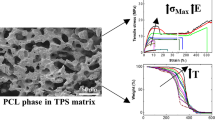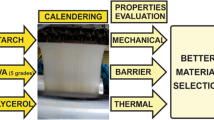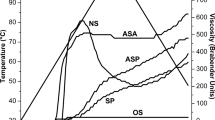Abstract
Poly(hydroxybutyrate-co-valerate) (PHBV) is a completely biodegradable thermoplastic polyester produced by microbial fermentation. The current market price of PHBV is significantly higher than that of commodity plastics such as polyethylene and polystyrene. It is therefore desirable to develop low-cost PHBV based materials to improve market opportunities for PHBV. We have produced low-cost environmentally compatible materials by blending PHBV with granular starch and environmentally benign CaCO3. Such materials can be used for specific applications where product biodegradability is a key factor and where certain mechanical properties can be compromised at the expense of lower cost. The inclusion of granular starch (25 wt%) and CaCO3 (10 wt%) in a PHBV matrix (8% HV, 5% plasticizer) reduces the cost by approximately 40% and has a tensile strength of 16 MPa and flexural modulus of 2.0 Gpa, while the unfilled PHBV/plasticizer matrix has a tensile strength of 27 MPa and a flexural modulus of 1.6 GPa.
Similar content being viewed by others
References
Zeneca, Inc. (1993)Biopol: Properties and Processing. Official information brochure.
W. M. Doane, C. L. Swanson, and G. F. Fanta (1992) in R. M. Rowell, T. P. Schultz, and R. Narayan (Ed.),Emerging Technologies for Materials and Chemicals from Biomass, ACS Symposium Series No. 476, American Chemical Society, Washington, DC, pp. 197–230.
G. Lay, J. Rehm, R. F. Stepto, M. Thoma, J. Sachetto, D. Lentz, and J. Silbiger (1992) U.S. Patent 5,095,054.
M. Yasin, S. J. Holland, A. M. Jolly, and B. J. Tighe (1989)Biomaterials 10 400–412.
S. T. Tanna, R. Gross, and S. P. McCarthy (1992)ACS Polym. Preprints 67 294–295.
B. A. Ramsay, V. Langlade, P. J. Carreau, and J. A. Ramsay (1993)Appl. Environ. Microbio. 59 1242–1246.
M. F. Koenig and S. J. Huang (1992)ACS Polym. Preprints 67 290–291.
A. J. Owen, J. Heinzel, Z. Skrbic, and V. Divjakovic (1992)Polymer 33 1563–1567.
P. A. Holmes (1988) in D. C. Bassett (Ed.),Developments in Crystalline Polymers, Vol. 2, Elsevier, London, pp. 1–65.
L. Nicolais and M. Narkis (1971)Polym. Eng. Sci. 11 194–199.
J. C. Halpin and J. L. Kardos (1976)Polym. Eng. Sci. 16 344–352.
L. E. Nielsen (1974)Mechanical Properties of Polymers and Composites, Vol. 2, Marcel Dekker, New York, pp. 379–452.
J. L. Willett (1994)J. Appl. Polym. Sci. 54 1685–1695.
J. Schroeter and M. Hobelsberger (1992)Starch/Starke 44 247–252.
J. P. Queslel and J. E. Mark (1986) in H. F. Mark, N. M. Bikales, C. G. Overberger, and G. Menges (Eds.),Encyclopedia of Polymer Science and Engineering, Vol. 5, John Wiley & Sons, New York, pp. 365–410.
Author information
Authors and Affiliations
Additional information
The mention of firm names or trade products does not imply that they are endorsed or recommended by the U.S. Department of Agriculture over other firms or similar products not mentioned.
Rights and permissions
About this article
Cite this article
Kotnis, M.A., O'Brien, G.S. & Willett, J.L. Processing and mechanical properties of biodegradable Poly(hydroxybutyrate-co-valerate)-starch compositions. J Environ Polym Degr 3, 97–105 (1995). https://doi.org/10.1007/BF02067485
Issue Date:
DOI: https://doi.org/10.1007/BF02067485




